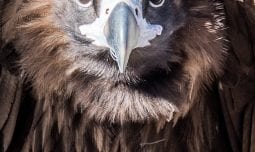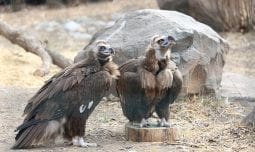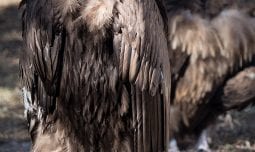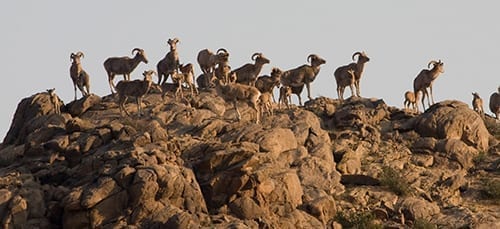Classification
The cinereous vulture has also been called the European black vulture.
Class Aves
Order Falconiformes
Family Accipitridae
Genus Aegypius
Species monachus
Habitat & Range
Open terrain, steppes and mountainous areas up to altitudes of 23,000 feet.
The cinereous vulture ranges through southern and eastern Europe, the Middle East (Iran, Afghanistan), central Asia, and into Mongolia and southern China.

Cinereous Vulture
Aegypius monachus
Cinereous vultures are scavengers. Their diet consists mainly of carrion – the remains of dead animals. They have several adaptations for feeding on carrion. The lack of feathers on their head helps them keep from getting messy while eating. Their strong hooked beaks are adapted for tearing chunks of flesh off the carcass. They even have a third eyelid that protects their eyes from blood and flesh. Although a diet of dead animals may sound unappetizing, vultures are actually recycling by utilizing carrion as a food source. They also help clean up the environment and therefore perform an important function as part of nature’s “clean up crew”.
Adaptations
High Flyers
Cinereous vultures have extremely long, broad wings that give them the ability to soar high in the air. Soaring conserves energy and allows the birds to cover great distances in search of carrion. Cinereous vultures have been observed on Mount Everest at altitudes of up to 23,000 feet (four miles high!) but they must descend to lower elevations to feed. Their exceptional eyesight enables these birds to spot a potential meal from high above the ground.
Dinner to Die For
Cinereous vultures are scavengers. Their diet consists mainly of carrion – the remains of dead animals. They have several adaptations for feeding on carrion. The lack of feathers on their head helps them keep from getting messy while eating. Their strong hooked beaks are adapted for tearing chunks of flesh off the carcass. They even have a third eyelid that protects their eyes from blood and flesh. Although a diet of dead animals may sound unappetizing, vultures are actually recycling by utilizing carrion as a food source. They also help clean up the environment and therefore perform an important function as part of nature’s “clean up crew”.
Physical Description
- Cinereous vultures are 39-43 inches (100-110 cm) in length.
- Wingspan is eight to nine and a half feet (2.5-2.9 m).
- Males weigh 15-26 pounds (6.8-11.8 kg); females weigh 16-28 pounds (7.3-12.7 kg).
- These vultures have dark brown feathers on the body with bluish gray skin on the head, neck and legs.
- They have a hooked beak and large feet with powerful talons.
Diet
What Does It Eat?
In the wild: Carrion from large mammals and occasionally rodents and small reptiles.
At the zoo: Bird of prey diet, rats and mice.
What Eats It?
The adult bird has few natural enemies.
Social Organization
Unlike other vultures, cinereous vultures are solitary except for mated pairs with chicks. Small groups may gather to feed on a carcass. This vulture species will rob other diurnal raptors of food sources due to their large size!
Life Cycle
Cinereous vultures are not sexually mature until they are five to six years old. Little is known about the courtship behavior of this species but they do form monogamous bonds for life. Mated pairs build a large nest on the tops of trees or on rock ledges. The nest is composed of branches and grasses lined with soft materials. Nests are reused year after year. Usually only one egg is laid. Both parents incubate the egg, which hatches in 50-55 days. Both parents are involved in rearing the young. For the first two months, one parent will constantly remain at the nest site to guard and protect the young chick. The chick is fed regurgitated food by both parents. Fledging occurs at 95-120 days. Lifespan in the wild is unknown but they live up to 38 years in captivity.
Fun Facts
- Juveniles have black plumage with pink skin on the head, neck and legs.
- Vultures have elastic stomach walls enabling them to eat large quantities of food at a time.
- In hot climates, vultures help control their temperature by defecating on their legs.
Conservation Status
IUCN Status: Near Threatened
Cinereous vultures are threatened by hunting, poisoning, habitat destruction and the reduction of available wild and domestic food sources throughout most of their range. The Denver Zoo participates in the Species Survival Plan for this bird and is also involved in a project for the development of assisted reproductive technologies for cinereous vultures. Several European countries are releasing captive-bred vultures back into the wild and have established programs to protect breeding sites for cinereous vultures. In an effort to help this and other vulture species, Spain has opened several “vulture restaurants”. At these sites, dead deer and sheep are left to make sure the vultures in those areas get enough to eat.

Download the App!
Get the FREE Denver Zoo app today, and be a pro the next time you visit the Zoo. You’ll get access to the Zoo map, daily activities and schedules, animal facts, and more. You can even load your membership card onto the app for additional convenience. It puts everything you need for an amazing Zoo experience right into the palm of your hand!








